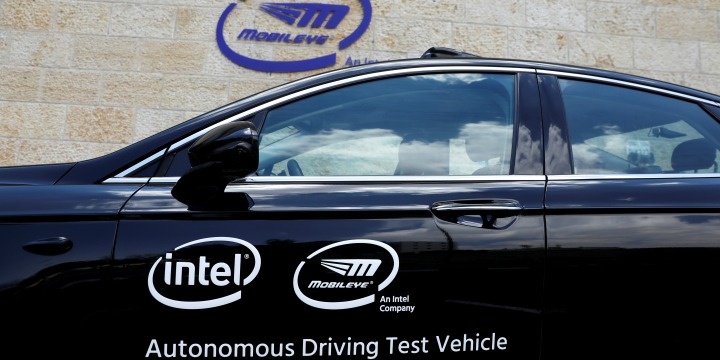Robotaxis Are a Necessary Stepping Stone for Driverless Cars, Says Mobileye CEO
 by Omer Kabir / CTech
by Omer Kabir / CTech

A Mobileye autonomous driving test vehicle, at the Mobileye headquarters in Jerusalem, May 15, 2018. Photo: Reuters / Ronen Zvulun.
CTech – Commercial manufacturing of autonomous cars for the private market will need to wait until autonomous taxis are widespread and entrenched as an industry, Mobileye CEO Amnon Shashua stated Thursday in an article posted to Intel’s website. His words differ from statements made a few years ago by autonomous vehicle developers, Mobileye among them, who predicted such cars will reach the private market by the beginning of the next decade.
Today, a large part of the car industry understands that those phases — robotaxis and private autonomous cars — cannot progress simultaneously, Shashua said.
“Series-production passenger car autonomy (SAE levels 4-5) must wait until the robotaxi industry deploys and matures,” Shashua wrote. “This is due to three factors: cost, regulation, and geographic scale.” Optimizing all three at the same time has proved to be too difficult, he said, leading many industry players to rethink their approach of reaching large-scale production, with a larger number now setting their sights first on commercial self-driving.
Hints of Shashua’s change in priorities could be detected in October 2018, when Mobileye announced a partnership with Volkswagen and Israeli car importer and distributor Champion Motors to launch a self-driving taxi service in Israel in early 2019. In a January interview with Calcalist, Shashua said the partnership plans to have hundreds of autonomous taxis on Tel Aviv’s streets by 2022. But this is the most outspoken Mobileye’s CEO, and indirectly Intel, have been about postponing their autonomous car vision, positioning themselves alongside players like Alphabet’s Waymo, which already operates a robotaxi fleet in Phoenix, Arizona.
“A self-driving system (SDS) with their cameras, radars, lidars, and high-performance computing is in the tens of thousands of dollars and will remain so in the foreseeable future,” Shashua wrote. While a business can handle such expenses, he said, it is too expensive for commercial production of passenger cars.
As for regulation, he said, “beside the fact that laws for granting a license to drive are geared towards human drivers, there is the serious issue of how to balance safety and usefulness in a manner that is acceptable to society.” The geographical factor is the challenge of creating the accurate, high-quality maps needed for private self-driving vehicles. Robotaxis, on the other hand, can be limited to a specific geographical area, meaning they are viable before the industry fully matures.
 US Stops UN From Recognizing a Palestinian State Through Membership
US Stops UN From Recognizing a Palestinian State Through Membership Jordan Reaffirms Commitment to Peace With Israel After Iran Attack, Says Ending Treaty Would Hurt Palestinians
Jordan Reaffirms Commitment to Peace With Israel After Iran Attack, Says Ending Treaty Would Hurt Palestinians ‘Crisis at Columbia’: Elite University Spirals Into Chaos Against Backdrop of School President’s DC Testimony
‘Crisis at Columbia’: Elite University Spirals Into Chaos Against Backdrop of School President’s DC Testimony ‘A Time for Vigilance’: FBI Director Says Agency on Alert for Threats Against Jewish Community During Passover
‘A Time for Vigilance’: FBI Director Says Agency on Alert for Threats Against Jewish Community During Passover New Haggadah Released for Israeli Soldiers in Gaza Ahead of Passover
New Haggadah Released for Israeli Soldiers in Gaza Ahead of Passover ADL Data Reveals Alarming Campus Antisemitism, Despite Strong Jewish Life
ADL Data Reveals Alarming Campus Antisemitism, Despite Strong Jewish Life New Hospital Approved for Construction in Southern Israel Amid Gaza War
New Hospital Approved for Construction in Southern Israel Amid Gaza War UN Security Council to Vote Thursday on Palestinian UN Membership
UN Security Council to Vote Thursday on Palestinian UN Membership New Play Opening in NY Recounts Verbatim Testimonies From Oct. 7 Survivors, Families of Victims
New Play Opening in NY Recounts Verbatim Testimonies From Oct. 7 Survivors, Families of Victims



 Gaza Terrorist Spokesperson Reveals How Media Falls for Terror Group’s Lies
Gaza Terrorist Spokesperson Reveals How Media Falls for Terror Group’s Lies Jordan Reaffirms Commitment to Peace With Israel After Iran Attack, Says Ending Treaty Would Hurt Palestinians
Jordan Reaffirms Commitment to Peace With Israel After Iran Attack, Says Ending Treaty Would Hurt Palestinians ‘Washington Post’ Platforms Superficial ‘As a Jew’ Op-Ed on Israel & Gaza
‘Washington Post’ Platforms Superficial ‘As a Jew’ Op-Ed on Israel & Gaza US Stops UN From Recognizing a Palestinian State Through Membership
US Stops UN From Recognizing a Palestinian State Through Membership Understanding the Meaning of Elijah This Passover
Understanding the Meaning of Elijah This Passover